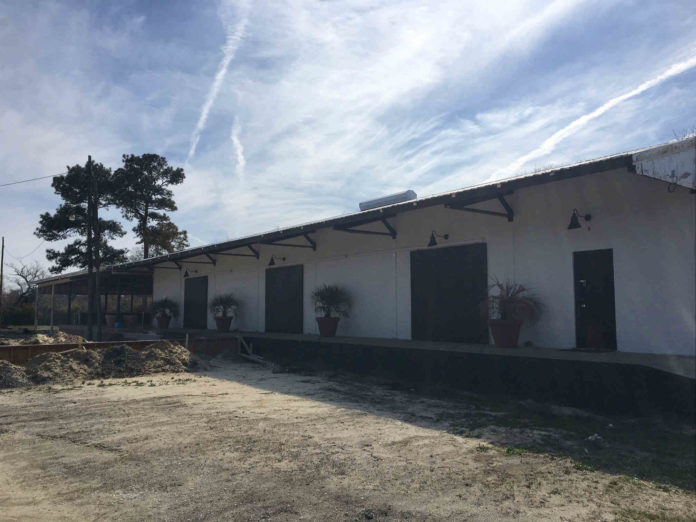
By Stefanie Jackson – After a lengthy debate Tuesday night, the Northampton planning commission approved a minor special use permit to convert an old farm shed into a new business that will offer its patrons a farm-to-table dining experience and more.
“This is textbook adaptive reuse,” said Eyre Baldwin, of Pearl LLC, the applicant. He has been deeply involved in adaptive reuse projects in Northampton County for the past 12 years and he says he has a “good track record.”
The building is located in the Capeville district, on Latimer Siding Road by Route 13, about a mile or two from the Chesapeake Bay Bridge-Tunnel exit, past the Eastern Shore of Virginia Welcome Center and Sunset Beach Resort.
The concept that county planning staff termed a restaurant and country store is better described as a “food hub,” a business model gaining popularity across the country, Baldwin said.
A food hub is a platform for small, local businesses to sell wholesale, retail, and value-added food products. For example, a clammer could sell fresh clams by the dozen, and those same clams could be steamed and served onsite alongside a local craft beer, Baldwin explained.
There are 18 local businesses interested in the venture, he said.
“It also directs people for further interest,” Baldwin continued. For example, an ice cream shop in Cape Charles could sell its product by the pint or quart at the food hub.
The proposed business is also directly across the street from the addition to the Magothy Bay Natural Area Preserve and behind the Southern Tip Bike and Hike Trail, and its restrooms would be open to visitors of either attraction.
Commissioner Janet Sturgis called the food hub a “fabulous idea” before the planning commission bombarded Baldwin with questions about his plans and the conditions for approval of the special use permit (SUP).
Sturgis was concerned that the project site plan did not indicate the future intended use of two other buildings on the property, which once provided housing for farm laborers.
“The main labor camp will never be occupied,” and its buildings will only be used for storage, Baldwin assured commissioners. However, two “boss man” apartments in “horrendous” condition may be renovated into one 2,000-square-foot apartment to “rent to one of the people who work for us, as they can watch it when we’re not there.”
“That needs to be on the plans,” Sturgis said.
“The only thing we’re applying for today” is the adaptive reuse of the shed “to get all these people working by summertime,” Baldwin said.
“We run into trouble when we add things, and add things, and add things,” Sturgis cautioned.
Commissioner Sarah Morgan added, “We do have the responsibility to find out what we need to know about your plans for this, so that we feel comfortable giving you the high five on it.
“And there have been instances in this county also, where people got permitted to do one thing and ended up doing something else,” she reminded Baldwin.
Commissioner Glen Anders questioned why the plan was designed with more than 40 parking spaces. The restaurant portion of the business will have a maximum capacity of 50 guests.
Baldwin said the plans were designed according to Senior Planner Kelley Parks’ recommendations, and Anders wondered aloud why staff hadn’t informed planning commissioners of all its recommendations.
Anders also asked how potential customers would know about the business since it isn’t visible from the highway when traveling northbound.
Baldwin said the business would be promoted through social media and connections with local welcome centers, campgrounds, and tourism-friendly towns, otherwise he’s made “the biggest mistake of my life.”
The planning commission interrogated Baldwin about the various easements related to the site.
Sturgis demanded a copy of the easement for the drain fields to the 4,500-gallon septic system, even though the easement’s location in the Northampton County deed book was noted on the site plan.
There is also a landscaping easement that will allow clearing of debris and plants that present a nuisance, like privet, a shrub with poisonous berries.
The planning commission wanted to see the easement to ensure that the required vegetative screening in front of the buildings would not be removed.
Morgan asked about requirements for outdoor lights and signs. Baldwin said new lights had been installed “exactly where the old ones were.”
A new sign will be painted on the side of the building in the same area as the original sign. Baldwin noted the sign will require a separate special use permit because “we’re in Northampton County and we’re always going to make up our own rules.”
The continuous line of questioning seemed to take a toll on the applicant, who said he’s working to make Northampton County better and create jobs.
“I’ve tried to make a difference on urban blight,” Baldwin said. “Every project that I go into, the first thing I do is clean it up. … Whether I get this permit or not … we’ve spent a lot of money on cleaning it up” and “wiped out all the hazards, including a massive hole in the ground.”
“If it’s postponed, you’re going to put a lot of people out of business for a long time … but if that means nothing to you …” he trailed off as planning commissioners interjected further comments.
After more than an hour of discussion, planning commissioners settled on a motion to approve the SUP, with 10 conditions that addressed all the concerns they had raised in open session, plus a few extra.
For example, no outdoor music will be permitted after 9 p.m., and the SUP will expire upon the sale of the property.
The motion passed unanimously.
Before the project can proceed, it will require final approval from Northampton supervisors following a public hearing April 9.


